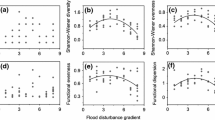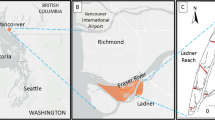Abstract
Although several studies have demonstrated that disturbance contributes to species’ diversity, little emphasis has been placed on the identification of species’ coexistence mechanisms related to life history traits. In this study, we compared species’ richness and components of plant communities around river confluences to explore how disturbance promotes the coexistence of species with different life history traits. Sites upstream and downstream of confluences are ideal for such comparisons because they draw on the same species’ pools and have similar ambient conditions, but differ markedly in the extents of flooding disturbance. We compared sites upstream and downstream of confluences by calculating species’ richness and community similarity indices for several life history traits in both summer and spring. In summer, the combined richness of all the species, of annual- and summer-flowering species, was higher downstream from confluences than upstream, but this was not the case for perennials. Similarity analyses suggested that plant communities are constructed according to a neutral process, whereby interactions between the coexisting species are neutral. However, in spring, species’ richness was similar upstream and downstream of confluences for all life history traits. Similarity analyses suggested that under these circumstances, the communities were constructed through a species-sorting process; i.e., each life history trait had a distinct habitat preference. Thus, the relative strengths of different community assembly processes may change seasonally. We concluded that species groups differing in their responses to disturbance may coexist in a single community. Thus, community structuring following disturbance may involve two processes: a neutral and a species-sorting process. The relative importance of each may vary between species’ life history traits and between seasons, and the interaction may account for current community structures.





Similar content being viewed by others
References
Benda L, Poff NL, Miller D, Dunne T, Reeves G, Pess G, Pollock M (2004) The network dynamics hypothesis: how channel networks structure riverine habitats. Bioscience 54:413–427
Brederveld RJ, Brunzel S, Lorenz AW, Jahnig SC, Soons MB (2011) Dispersal is a limiting factor in the colonization of restored mountain streams by plants and macroinvertebrates. J Appl Ecol 48:1241–1250
Bunn SE, Arthington AH (2002) Basic principles and ecological consequences of altered flow regimes for aquatic biodiversity. Environ Manag 30(4):492–507
Chesson P (1991) A need for niches? Trends Ecol Evol 6:26–28
Chesson P, Huntly N (1997) The roles of harsh and fluctuating conditions in the dynamics of ecological communities. Am Nat 150:519–553
Connell JH (1978) Diversity in tropical rain forests and coral reefs. Science 199:1302
Dial R, Roughgarden J (1998) Theory of marine communities: the intermediate disturbance hypothesis. Ecology 79:1412–1424
Ferreira LV, Stohlgren TJ (1999) Effects of river level fluctuation on plant species richness, diversity, and distribution in a floodplain forest in Central Amazonia. Oecologia 120:582–587
Fox JF (1979) Intermediate-disturbance hypothesis. Science 204:1344
Greet J, Cousens RD, Webb JA (2013) Seasonal timing of inundation affects ripa rian plant growth and flowering: implications for riparian vegetation composition. Plant Ecol 214:87–101
Groombridge B (1992) Global biodiversity: status of the earth’s living resources. Chapman & Hall, London
Hubbell SP (2001) The unified neutral theory of biodiversity and biogeography. Princeton University Press, Princeton
Hubbell SP (2003) Modes of speciation and the lifespans of species under neutrality: a response to the comment of Robert E. Ricklefs. Oikos 100:193
Huston M (1979) A general hypothesis of species diversity. American naturalist 81–101
Huston MA, Karr JR (1994) Biological diversity. Cambridge University Press, Cambridge
HyogoPrefecture (2007) Research of Natural Environment of River, Kobe
O’Hare JM, O’Hare MT, Gurnell AM, Dunbar MJ, Scarlett PM, Laize C (2011) Physical constraints on the distribution of macrophytes linked with flow and sediment dynamics in British rivers. River Res Appl 27:671–683
Osawa T, Mitsuhashi H, Niwa H, Ushimaru A (2010a) Differences in distribution patterns around river confluences among hydrophilic vegetation groups. Ecol Res 25:1161–1169
Osawa T, Mitsuhashi H, Niwa H, Ushimaru A (2010b) High diversity at network nodes: river confluences enhance vegetation diversity. Open Ecol J 3:48–58
Osawa T, Mitsuhashi H, Ushimaru A (2010c) River confluences enhance riparian plant species diversity. Plant Ecol 209:95–108
Paine CET, Harms KE (2009) Quantifying the effects of seed arrival and environmental conditions on tropical seedling community structure. Oecologia 160:139–150
Pollock MM, Naiman RJ, Hanley TA (1998) Plant species richness in riparian wetlands - A test of biodiversity theory. Ecology 79:94–105
Questad EJ, Foster BL (2008) Coexistence through spatio-temporal heterogeneity and species sorting in grassland plant communities. Ecol Lett 11:717–726
Ricklefs RE, Schluter D (1993) Species diversity in ecological communities: historical and geographical perspectives. University of Chicago Press, Chicago
Rominger AJ, Miller TEX, Collins SL (2009) Relative contributions of neutral and niche-based processes to the structure of a desert grassland grasshopper community. Oecologia 161:791–800
Roxburgh SH, Shea K, Wilson JB (2004) The intermediate disturbance hypothesis: patch dynamics and mechanisms of species coexistence. Ecology 85:359–371
Satake Y, Ohi J, Kitamura S, Watari S, Tominari T (1981) Wild flowers of Japan III. Heibonsya, Tokyo
Satake Y, Ohi J, Kitamura S, Watari S, Tominari T (1982a) Wid flowers of Japan I. Heibonsya, Tokyo
Satake Y, Ohi J, Kitamura S, Watari S, Tominari T (1982b) Wild flowers of Japan II. Heibonsya, Tokyo
Satake Y, Hara H, Watari S, Tominari T (1989a) Wild flower of Japan, Woody I. Heibonsya, Tokyo
Satake Y, Hara H, Watari S, Tominari T (1989b) Wild flower of Japan, woody II. Heibonsya, Tokyo
Shea K, Roxburgh SH, Rauschert ESJ (2004) Moving from pattern to process: coexistence mechanisms under intermediate disturbance regimes. Ecol Lett 7:491–508
Sheil D, Burslem DFRP (2003) Disturbing hypotheses in tropical forests. Trends Ecol Evol 18:18–26
Sousa WP (1979) Disturbance in marine intertidal boulder fields: the nonequilibrium maintenance of species diversity. Ecology 60:1225–1239
Thompson R, Townsend C (2006) A truce with neutral theory: local deterministic factors, species traits and dispersal limitation together determine patterns of diversity in stream invertebrates. J Anim Ecol 75:476–484
van Eck W, van de Steeg HM, Blom C, de Kroon H (2004) Is tolerance to summer flooding correlated with distribution patterns in river floodplains? A comparative study of 20 terrestrial grassland species. Oikos 107:393–405
van Eck W, Lenssen JPM, van de Steeg HM, Blom C, de Kroon H (2006) Seasonal dependent effects of flooding on plant species survival and zonation: a comparative study of 10 terrestrial grassland species. Hydrobiologia 565:59–69
Vervuren PJA, Blom C, de Kroon H (2003) Extreme flooding events on the Rhine and the survival and distribution of riparian plant species. J Ecol 91:135–146
Acknowledgments
The authors thank the members of the Ecology Division in The Museum of Nature and Human Activities Hyogo and the Biodiversity Laboratory at Kobe University for their valuable supports. The authors also thank Drs. T. Miyashita and A. Koyama for commenting on an earlier version of this manuscript.
Author information
Authors and Affiliations
Corresponding author
Additional information
Communicated by L. Olsvig-Whittaker.
Rights and permissions
About this article
Cite this article
Osawa, T., Mitsuhashi, H. & Ushimaru, A. Plant species’ coexistence relationships may shift according to life history traits and seasons. Plant Ecol 215, 597–612 (2014). https://doi.org/10.1007/s11258-014-0325-z
Received:
Accepted:
Published:
Issue Date:
DOI: https://doi.org/10.1007/s11258-014-0325-z




